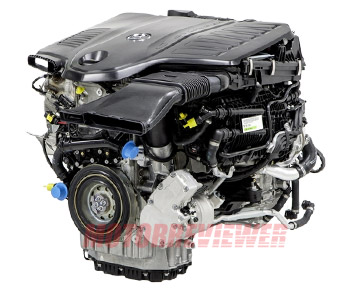Mercedes M256 3.0L Engine Specs, Problems, Reliability, Info

The Mercedes-Benz M256, the newest 3.0-liter inline six-cylinder gasoline engine, is a member of Mercedes modular engine family that includes four-cylinder M260/M264 engines and OM656/OM654 diesels. The M256 3.0L engine was firstly introduced in the 2017 S-Class W222 S450 and S500 models. The Mercedes hasn't been producing inline-six engines for a long time since the last one - the M104, and now, this new 3.0-liter engine is gradually and effectively replacing the previous M276 V6 engine.
The M256 has a die-cast aluminum cylinder block. The cylinder walls are machined with a twin-wire-arc spraying method (TWAS). This method sprays a low-friction coating Nanoslide. Mercedes-Benz patented Nanoslide coating creates a microporous surface of the cylinder walls and reduces friction losses compared to traditional cast-iron cylinder liners. The cylinder-bore spacing is 90 mm - unified across the new family. The engine has a forged-steel crankshaft and connecting rods. The distance between the cylinder bore centers is 90 mm - a uniform size for the new family. The pistons are equipped with reduced piston rings and oil cooling ducts lowering the temperature of piston crowns.
The cylinder head for the M256 engine is produced from an aluminum-silicon alloy. There are two intake valves and two exhaust valves per each cylinder. For the first time, Mercedes uses sodium-cooled, hollow flat-seat exhaust valves. Valves are actuated by two overhead camshafts via roller cam followers. The intake and exhaust camshafts are driven by a timing-chain located on the flywheel side via the camshaft drive gear. The timing chain also drives the high-pressure fuel pump and the oil pump. The M256 cylinder head is equipped with M10 thread spark plugs for better cooling to be achieved in the head. The M256 is also equipped with variable engine timing (for the intake and exhaust valves) and variable valve lift on the intake side (Mercedes-Benz CAMTRONIC). The adjustment range for the intake camshaft has been increased to a 70 degrees crank angle. Like the most modern engines, the M256 is equipped with the high-pressure direct fuel injection system with highly precise piezo injectors.
The M256 Mercedes-Benz engine features the integrated starter-alternator (ISG) installed between the engine and automatic transmission. This option became available, thanks to a 48V on-board electrical system. The ISG is rigidly bolted to the crankshaft and exchanges energy between the driveshaft and the 48V lithium-ion battery with an energy content of almost 1 kWh. The 48V electrical system also supplies power to the electric water pump and air conditioning compressor. Air charging is the next key feature of the M256 engine. The M256 has a twin-scroll turbocharger with air gap-insulated exhaust manifold, plus an electric additional compressor (eZV) that is integrated into the 48 volts electrical system. The electric auxiliary compressor eliminates the turbo lag effect (it accelerates to 70,000 rpm within 300 ms).
Like M264 inline fours and M176 V8s, the M256 has a petrol/gasoline particulate filter (OPF), which works similarly to DPF in diesel vehicles. The engine meets Euro 6 Standard 2.
Engine Specs
Oil recommendations and capacity may vary depending on the car model, year, and market. Please check the service manual specific to your vehicle!
Mercedes M256 Problems and Reliability
The M256 engines are still new and do not have enough statistics on common problems and failures. But it is worth remembering that modern Mercedes engines are quite demanding on the quality of fuels and oils. Also, direct-injected engines are often prone to carbon deposits on intake valves.
Modifications
M256 E30 DEH LA R (reduced version) - 362 hp (270 kW) at 5,500-6,100 rpm and 369 lb-ft (500 Nm) of torque at 1,600-4,000 rpm (output is without ISA). Application: S-Class W222, CLS-Class C257, AMG GT, and GLE-Class V167. M256 E30 DEH LA G (increased output version) - 429 hp (320 kW) at 5,900-6,100 rpm and 384 lb-ft (520 Nm) of torque at 1,800-5,500 rpm (output is without ISA). Application: S-Class W222, CLS-Class C257, AMG GT, GLE-Class V167, and E-Class W213.
